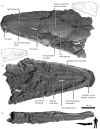Giant gar from directly above the Cretaceous-Palaeogene boundary suggests healthy freshwater ecosystems existed within thousands of years of the asteroid impact
- PMID: 35702983
- PMCID: PMC9198771
- DOI: 10.1098/rsbl.2022.0118
Giant gar from directly above the Cretaceous-Palaeogene boundary suggests healthy freshwater ecosystems existed within thousands of years of the asteroid impact
Abstract
The Cretaceous-Palaeogene (K-Pg) mass extinction was responsible for the destruction of global ecosystems and loss of approximately three-quarters of species diversity 66 million years ago. Large-bodied land vertebrates suffered high extinction rates, whereas small-bodied vertebrates living in freshwater ecosystems were buffered from the worst effects. Here, we report a new species of large-bodied (1.4-1.5 m) gar based on a complete skeleton from the Williston Basin of North America. The new species was recovered 18 cm above the K-Pg boundary, making it one of the oldest articulated vertebrate fossils from the Cenozoic. The presence of this freshwater macropredator approximately 1.5-2.5 thousand years after the asteroid impact suggests the rapid recovery and reassembly of North American freshwater food webs and ecosystems after the mass extinction.
Keywords: Fish; K–Pg; Lepisosteidae; Lilliput effect; gar.
Figures


Similar articles
-
Late Cretaceous restructuring of terrestrial communities facilitated the end-Cretaceous mass extinction in North America.Proc Natl Acad Sci U S A. 2012 Nov 13;109(46):18857-61. doi: 10.1073/pnas.1202196109. Epub 2012 Oct 29. Proc Natl Acad Sci U S A. 2012. PMID: 23112149 Free PMC article.
-
Two pulses of morphological diversification in Pacific pelagic fishes following the Cretaceous-Palaeogene mass extinction.Proc Biol Sci. 2018 Oct 10;285(1888):20181194. doi: 10.1098/rspb.2018.1194. Proc Biol Sci. 2018. PMID: 30305432 Free PMC article.
-
High morphological disparity in a bizarre Paleocene fauna of predatory freshwater reptiles.BMC Ecol Evol. 2022 Mar 21;22(1):34. doi: 10.1186/s12862-022-01985-z. BMC Ecol Evol. 2022. PMID: 35313822 Free PMC article.
-
The Chicxulub asteroid impact and mass extinction at the Cretaceous-Paleogene boundary.Science. 2010 Mar 5;327(5970):1214-8. doi: 10.1126/science.1177265. Science. 2010. PMID: 20203042 Review.
-
Rapid turnover of top predators in African terrestrial faunas around the Permian-Triassic mass extinction.Curr Biol. 2023 Jun 5;33(11):2283-2290.e3. doi: 10.1016/j.cub.2023.04.007. Epub 2023 May 22. Curr Biol. 2023. PMID: 37220743 Review.
Cited by
-
Bat consumption by holostean fishes in the Eocene Lake Messel: insights into the trophic adaptability of extinct gars and bowfins.Biol Lett. 2024 Sep;20(9):20240194. doi: 10.1098/rsbl.2024.0194. Epub 2024 Sep 4. Biol Lett. 2024. PMID: 39226920
-
Freshwater fish and the Cretaceous/Palaeogene boundary: a critical assessment of survivorship patterns.Proc Biol Sci. 2024 Aug;291(2029):20241025. doi: 10.1098/rspb.2024.1025. Epub 2024 Aug 28. Proc Biol Sci. 2024. PMID: 39196282
-
Genomes of the Orestias pupfish from the Andean Altiplano shed light on their evolutionary history and phylogenetic relationships within Cyprinodontiformes.BMC Genomics. 2024 Jun 18;25(1):614. doi: 10.1186/s12864-024-10416-w. BMC Genomics. 2024. PMID: 38890559 Free PMC article.
References
MeSH terms
Associated data
LinkOut - more resources
Full Text Sources

